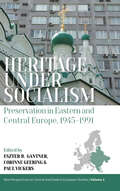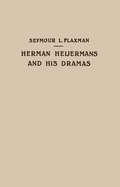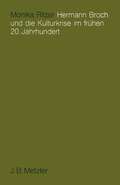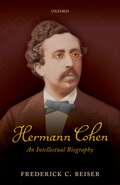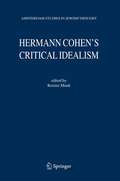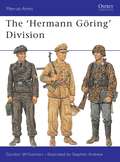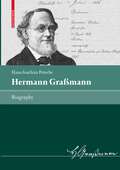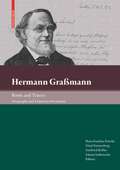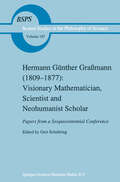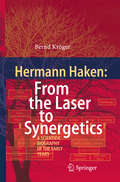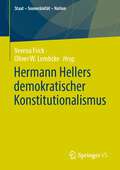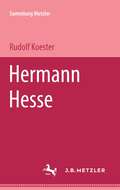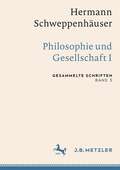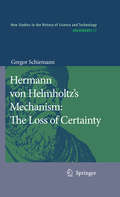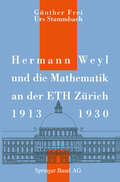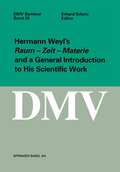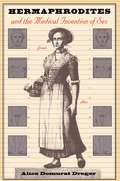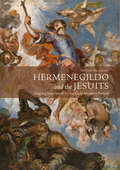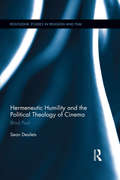- Table View
- List View
Heritage under Socialism: Preservation in Eastern and Central Europe, 1945–1991 (New Perspectives on Central and Eastern European Studies #2)
by Eszter Gantner, Corinne Geering, and Paul VickersHow was heritage understood and implemented in European socialist states after World War II? By exploring national and regional specificities within the broader context of internationalization, this volume enriches the conceptual, methodological and empirical scope of heritage studies through a series of fascinating case studies. Its transnational approach highlights the socialist world’s diverse interpretations of heritage and the ways in which they have shaped the trajectories of present-day preservation practices.
Heritage under Socialism: Preservation in Eastern and Central Europe, 1945–1991 (New Perspectives on Central and Eastern European Studies #2)
by Eszter Gantner, Corinne Geering, and Paul VickersHow was heritage understood and implemented in European socialist states after World War II? By exploring national and regional specificities within the broader context of internationalization, this volume enriches the conceptual, methodological and empirical scope of heritage studies through a series of fascinating case studies. Its transnational approach highlights the socialist world’s diverse interpretations of heritage and the ways in which they have shaped the trajectories of present-day preservation practices.
Heritage under Socialism: Preservation in Eastern and Central Europe, 1945–1991 (New Perspectives on Central and Eastern European Studies #2)
by Eszter Gantner Corinne Geering Paul VickersHow was heritage understood and implemented in European socialist states after World War II? By exploring national and regional specificities within the broader context of internationalization, this volume enriches the conceptual, methodological and empirical scope of heritage studies through a series of fascinating case studies. Its transnational approach highlights the socialist world’s diverse interpretations of heritage and the ways in which they have shaped the trajectories of present-day preservation practices.
Herman Heijermans and His Dramas
by Seymour L. FlaxmanDuring the last two decades of the nineteenth century the Dutch drama, which had lapsed into astate of somnolence since the glorious days of VondeI, suddenly awoke to vigorous life. Not only did gifted dramatists appear, but talented directors, actors, and actresses brought new splendor to the theatre. Yet this brilliant flame did not burst forth in a vacuum, and to appre ciate the quality of its light, it must be viewed against the back ground of its origins in the European drama. After the middle of the century the emphasis in literary creation had shifted from a subjective, emotional point of view to a more objective and rationalistic attitude. If this seems only a roundabout way of saying that Romanticism yielded its dominance to Realism and Naturalism, the conc1usion is justified, but we should not yield too readily to the pseudo-scientific mania which urges us to force literature into a genus and species type of c1assification. It is customary to say that in the eighties and nineties, Nat uralism won a decisive victory over Romanticism and drove the partisans of the older movement from the field. At first glance this does, indeed, appear to be true. Hugo yields to Zola, Pushkin to Tolstoi, Tieck to Hauptmann. It is all quite simple.
Hermann Cohen: An Intellectual Biography
by Frederick C. BeiserThis book is the first complete intellectual biography of Hermann Cohen (1842-1918) and the only work to cover all his major philosophical and Jewish writings. Frederick C. Beiser pays special attention to all phases of Cohen's intellectual development, its breaks and its continuities, throughout seven decades. The guiding goal behind Cohen's intellectual career, he argues, was the development of a radical rationalism, one committed to defending the rights of unending enquiry and unlimited criticism. Cohen's philosophy was therefore an attempt to defend and revive the Enlightenment belief in the authority of reason; his critical idealism an attempt to justify this belief and to establish a purely rational worldview. According to this interpretation, Cohen's thought is resolutely opposed to any form of irrationalism or mysticism because these would impose arbitrary and artificial limits on criticism and enquiry. It is therefore critical of those interpretations which see Cohen's philosophy as a species of proto-existentialism (Rosenzweig) or Jewish mysticism (Adelmann and Köhnke). Hermann Cohen: An Intellectual Biography attempts to unify the two sides of Cohen's thought, his philosophy and his Judaism. Maintaining that Cohen's Judaism was not a limit to his radical rationalism but a consistent development of it, Beiser contends that his religion was one of reason. He concludes that most critical interpretations have failed to appreciate the philosophical depth and sophistication of his Judaism, a religion which committed the believer to the unending search for truth and the striving to achieve the cosmopolitan ideals of reason.
Hermann Cohen: An Intellectual Biography
by Frederick C. BeiserThis book is the first complete intellectual biography of Hermann Cohen (1842-1918) and the only work to cover all his major philosophical and Jewish writings. Frederick C. Beiser pays special attention to all phases of Cohen's intellectual development, its breaks and its continuities, throughout seven decades. The guiding goal behind Cohen's intellectual career, he argues, was the development of a radical rationalism, one committed to defending the rights of unending enquiry and unlimited criticism. Cohen's philosophy was therefore an attempt to defend and revive the Enlightenment belief in the authority of reason; his critical idealism an attempt to justify this belief and to establish a purely rational worldview. According to this interpretation, Cohen's thought is resolutely opposed to any form of irrationalism or mysticism because these would impose arbitrary and artificial limits on criticism and enquiry. It is therefore critical of those interpretations which see Cohen's philosophy as a species of proto-existentialism (Rosenzweig) or Jewish mysticism (Adelmann and Köhnke). Hermann Cohen: An Intellectual Biography attempts to unify the two sides of Cohen's thought, his philosophy and his Judaism. Maintaining that Cohen's Judaism was not a limit to his radical rationalism but a consistent development of it, Beiser contends that his religion was one of reason. He concludes that most critical interpretations have failed to appreciate the philosophical depth and sophistication of his Judaism, a religion which committed the believer to the unending search for truth and the striving to achieve the cosmopolitan ideals of reason.
Hermann Cohen's Critical Idealism (Amsterdam Studies in Jewish Philosophy #10)
by Reinier W. MunkHermann Cohen (1842-1918) is an original systematic thinker and representative of the Marburg School of Critical Idealism. The Marburg School was a leading school in German academic philosophy and in German Jewish philosophy for a period of over thirty years preceding the First World War. Initially standing at the front of the ‘Return to Kant’ movement, Cohen subsequently went beyond Kant in developing a system of critical idealism in which he offered a critique of and alternative to absolute idealism, positivism, and materialism. A critical idealist in heart and soul, Cohen is also recognized as a man who embodied German Jewish culture. Publications on Cohen in the English language are small in number and this volume aims to fill the gap. It offers an analysis of Cohen’s System of Philosophy - the three-volume classic on logic, ethics, and aesthetics - and his writings on Judaism and religion. The book highlights Cohen’s contributions in these fields, including his discussions with Maimonides, Leibniz, Kant, and Hegel. It demonstrates the congeniality of Cohen’s critical idealism as expounded in the System and his writings on Judaism, and offers an overview of contemporary Cohen research.
The Hermann Göring Division (Men-at-Arms)
by Gordon Williamson Stephen AndrewEach of Germany's World War II armed services could claim one unit which earned a unique combat reputation, and which consequently was enlarged and developed far beyond the size originally planned. Hermann Göring, commander-in-chief of the air force, was determined that his Luftwaffe should share the glory of Germany's land conquests, and gave his name to a regimental combat group of infantry and Flak artillery. This élite unit was steadily enlarged into a brigade, then an armoured division, and finally into a two-division corps, fighting with distinction in Tunisia, Sicily, Italy, and on the Russian Front. This concise history is illustrated with rare personal photographs and eight colour plates, detailing the very varied uniforms and special insignia of this crack formation.
The Hermann Göring Division (Men-at-Arms #385)
by Gordon Williamson Stephen AndrewEach of Germany's World War II armed services could claim one unit which earned a unique combat reputation, and which consequently was enlarged and developed far beyond the size originally planned. Hermann Göring, commander-in-chief of the air force, was determined that his Luftwaffe should share the glory of Germany's land conquests, and gave his name to a regimental combat group of infantry and Flak artillery. This élite unit was steadily enlarged into a brigade, then an armoured division, and finally into a two-division corps, fighting with distinction in Tunisia, Sicily, Italy, and on the Russian Front. This concise history is illustrated with rare personal photographs and eight colour plates, detailing the very varied uniforms and special insignia of this crack formation.
Hermann Graßmann: Biography
by Hans-Joachim PetscheHermann Günther Graßmann was one of the most remarkable personalities in 19th-century science. A "small-town genius", he developed a groundbreaking n-dimensional algebra of space and contributed to a revolution in the understanding of mathematics. His work fascinated great mathematicians such as W. R. Hamilton, J. W. Gibbs and A. N. Whitehead. This intellectual biography traces Graßmann’s steps towards scientific brilliance by untangling a complicated web of influences: the force of unsolved problems in mathematics, Friedrich Schleiermacher’s Dialectic, German Romanticism and life in 19th-century Prussia. The book also introduces the reader to the details of Graßmann’s mathematical work without neglecting his achievements in Sanskrit philology and physics. And, for the first time, it makes many original sources accessible to the English-language reader.
Hermann Graßmann – Roots and Traces: Autographs and Unknown Documents
by Hans-Joachim Petsche Lloyd Kannenberg Gottfried Keßler Jolanta LiskowackaHermann Günther Graßmann was one of the 19th century’s most remarkable scientists, but many aspects of his life have remained in the dark. This book assembles essential, first-hand information on the Graßmann family. It sheds light on the family’s struggle for scientific knowledge, progress and education. It puts a face on the protagonists of an exciting development in the history of science. And it highlights the peculiar set of influences which led Hermann Graßmann to brilliant insights in mathematics, philology and physics. This book of sources is meant to complement the biography of Graßmann and the proceedings of the 2009 Graßmann Bicentennial Conference (Birkhäuser 2010). "Roots and Traces" will interest all scholars working on Hermann Graßmann and related topics. It offers newly discovered pictures of family members, historical texts documenting life in this exceptional family and an English translation of these previously unpublished papers. Text in German and English.
Hermann Günther Graßmann (Boston Studies in the Philosophy and History of Science #187)
by GertSchubringIn this volume specialists in mathematics, physics, and linguistics present the first comprehensive analysis of the ideas and influence of Hermann G. Graßmann (1809-1877), the remarkable universalist whose work recast the foundations of these disciplines and shaped the course of their modern development.
Hermann Haken: A Scientific Biography of the Early Years
by Bernd KrögerHermann Haken (born 1927) is one of the “fathers” of the quantum-mechanical laser theory, formulated between 1962 and 1966, in strong competition with American researchers. Later on, he created Synergetics, the science of cooperation in multicomponent systems.The book concentrates on the development of his scientific work during the first thirty-five years of his career.In 1970 he and his doctoral student Robert Graham were able to show that the laser is an example of a nonlinear system far from thermal equilibrium that shows a phase-transition like behavior. Subsequently, this insight opened the way for the formulation of Synergetics.Synergetics is able to explain, how very large systems show the phenomenon of self-organization that can be mathematically described by only very few order parameters. The results of Haken’s research were published in two seminal books Synergetics (1977) and Advanced Synergetics (1983).After the year 1985 Haken concentrated his research on the macroscopic foundation of Synergetics. This led him towards the application of synergetic principles in medicine, cognitive research and, finally, in psychology.A comprehensive bibliography of Hermann Haken’s publications (nearly 600 numbers) is included in the book.
Hermann Hellers demokratischer Konstitutionalismus (Staat – Souveränität – Nation)
by Verena Frick Oliver W. LembckeVon Haus aus Jurist und Staatsrechtslehrer, vertritt Hermann Heller einen demokratischen Konstitutionalismus, der die Wirklichkeit der Demokratie mit der Normativität des Rechts zusammendenkt. Was Hellers Werk dabei in besonderer Weise fruchtbar erscheinen lässt, ist die Verbindung von Staatsrechtslehre, Politikwissenschaft und Soziologie, die erst die komplexe Wirklichkeit der Demokratie erfahrbar macht. In seinen späten Weimarer Schriften – etwa zum Autoritären Liberalismus – zeigt sich Heller als Analytiker der Krise, der uns heute den Blick für die Herausbildung autoritärer Politikstrukturen insbesondere auf europäischer Ebene schärft. Neben dieser kritischen Perspektive auf die Konstellationen und Dynamiken der (zum Teil schleichenden) Autokratisierung politischer Prozesse lassen sich auf Grundlage des Hellerschen Werkes auch die Voraussetzungen gelingender demokratischer Stabilität benennen. Die Rekonstruktion dieses Ansatzes eines dezidiert demokratischen Konstitutionalismus steht im Zentrum des geplanten Sammelbandes.
Hermann Schweppenhäuser: Gesammelte Schriften, Band 3 (Gesammelte Schriften von Hermann Schweppenhäuser)
Der dritte Band der Gesammelten Schriften von Hermann Schweppenhäuser enthält im ersten Teil systematische Erörterungen sozialphilosophischer Begriffe, im zweiten Teil Abhandlungen mit philosophiegeschichtlichen Schwerpunkten (vom späten 18. bis zum Ende des 19. Jahrhunderts) und im dritten Teil Texte, die im Zusammenhang mit der akademischen philosophischen Lehre stehen. Ergänzt wird der Band durch einen Brief von Theodor W. Adorno aus dem Jahre 1960 und ein Nachwort von Schweppenhäusers langjährigen Kollegen Günther Mensching. Eine „spezifische Verbindung von scharfer Kritik am Üblichen und Konventionellen mit eindringlicher Besinnung auf die Verbindlichkeit vergangener geistiger Zeugnisse kennzeichnet, über die Gründer der Frankfurter Schule weit hinaus, die Denkweise Hermann Schweppenhäusers. Die Komplexität seines Stils macht die Anstrengung spürbar, Kontinuität und radikale Diskontinuität der europäischen Kultur, zumal der deutschen, zusammenzudenken. Kein anderes Mitglied der Schule hat sich so hingebungsvoll seinen Gegenständen zugewendet wie er.“ (Günther Mensching)
Hermann von Helmholtz’s Mechanism: A Study on the Transition from Classical to Modern Philosophy of Nature (Archimedes #17)
by Gregor SchiemannFocusing on Hermann von Helmholtz, this study addresses one of the nineteenth century’s most important German natural scientists. Among his most well-known contributions to science are the invention of the ophthalmoscope and grou- breaking work towards formulating the law of the conservation of energy. The volume of his work, reaching from medicine to physiology to physics and epis- mology, his impact on the development of the sciences far beyond German borders, and the contribution he made to the organization and popularization of research, all established Helmholtz’s prominence both in the academic world and in public cultural life. Helmholtz was also one of the last representatives of a conception of nature that strove to reduce all phenomena to matter in motion. In reaction to the increasingly insurmountable difficulties that program had in fulfilling its own standards for s- entific explanation, he developed elements of a modern understanding of science that have remained of fundamental importance to this day.
Hermann Weyl’s Raum - Zeit - Materie and a General Introduction to His Scientific Work (Oberwolfach Seminars #30)
by Erhard ScholzHistorical interest and studies of Weyl's role in the interplay between 20th-century mathematics, physics and philosophy have been increasing since the middle 1980s, triggered by different activities at the occasion of the centenary of his birth in 1985, and are far from being exhausted. The present book takes Weyl's "Raum - Zeit - Materie" (Space - Time - Matter) as center of concentration and starting field for a broader look at his work. The contributions in the first part of this volume discuss Weyl's deep involvement in relativity, cosmology and matter theories between the classical unified field theories and quantum physics from the perspective of a creative mind struggling against theories of nature restricted by the view of classical determinism. In the second part of this volume, a broad and detailed introduction is given to Weyl's work in the mathematical sciences in general and in philosophy. It covers the whole range of Weyl's mathematical and physical interests: real analysis, complex function theory and Riemann surfaces, elementary ergodic theory, foundations of mathematics, differential geometry, general relativity, Lie groups, quantum mechanics, and number theory.
Hermaphrodites and the Medical Invention of Sex
by Alice Domurat DregerPunctuated with remarkable case studies, this book explores extraordinary encounters between hermaphrodites--people born with "ambiguous" sexual anatomy--and the medical and scientific professionals who grappled with them. Alice Dreger focuses on events in France and Britain in the late nineteenth century, a moment of great tension for questions of sex roles. While feminists, homosexuals, and anthropological explorers openly questioned the natures and purposes of the two sexes, anatomical hermaphrodites suggested a deeper question: just how many human sexes are there? Ultimately hermaphrodites led doctors and scientists to another surprisingly difficult question: what is sex, really? Hermaphrodites and the Medical Invention of Sex takes us inside the doctors' chambers to see how and why medical and scientific men constructed sex, gender, and sexuality as they did, and especially how the material conformation of hermaphroditic bodies--when combined with social exigencies--forced peculiar constructions. Throughout the book Dreger indicates how this history can help us to understand present-day conceptualizations of sex, gender, and sexuality. This leads to an epilogue, where the author discusses and questions the protocols employed today in the treatment of intersexuals (people born hermaphroditic). Given the history she has recounted, should these protocols be reconsidered and revised? A meticulously researched account of a fascinating problem in the history of medicine, this book will compel the attention of historians, physicians, medical ethicists, intersexuals themselves, and anyone interested in the meanings and foundations of sexual identity.
Hermenegildo and the Jesuits: Staging Sainthood in the Early Modern Period
by Stefano MuneroniThis book explores the cultural conditions that led to the emergence and proliferation of Saint Hermenegildo as a stage character in the sixteenth and seventeenth centuries. It considers how this saint became a theatrical trope enabling the Society of Jesus to address religious and secular concerns of the post-Tridentine Church, and to discuss political issues such as the supremacy of the pope over the monarch and the legitimacy of regicide. The book goes on to explain how the Hermenegildo narrative developed outside of Jesuit colleges, through works by professional dramatist Lope de Vega and Mexican nun Juana Inés de la Cruz. Stefano Muneroni takes a global approach to the staging of Hermenegildo, tracing the character’s journey from Europe to the Americas, from male to female authors, and from a sacrificial to a sacramental paradigm where the emphasis shifts from bloodletting to spiritual salvation. Given its interdisciplinary approach, this book is geared toward scholars and students of theatre history, religion and drama, early modern theology, cultural studies, romance languages and literature, and the history of the Society of Jesus..
Hermenegildo and the Jesuits: Staging Sainthood in the Early Modern Period
by Stefano MuneroniThis book explores the cultural conditions that led to the emergence and proliferation of Saint Hermenegildo as a stage character in the sixteenth and seventeenth centuries. It considers how this saint became a theatrical trope enabling the Society of Jesus to address religious and secular concerns of the post-Tridentine Church, and to discuss political issues such as the supremacy of the pope over the monarch and the legitimacy of regicide. The book goes on to explain how the Hermenegildo narrative developed outside of Jesuit colleges, through works by professional dramatist Lope de Vega and Mexican nun Juana Inés de la Cruz. Stefano Muneroni takes a global approach to the staging of Hermenegildo, tracing the character’s journey from Europe to the Americas, from male to female authors, and from a sacrificial to a sacramental paradigm where the emphasis shifts from bloodletting to spiritual salvation. Given its interdisciplinary approach, this book is geared toward scholars and students of theatre history, religion and drama, early modern theology, cultural studies, romance languages and literature, and the history of the Society of Jesus..
Hermeneutic Humility and the Political Theology of Cinema: Blind Paul (Routledge Studies in Religion and Film)
by Sean DesiletsThis book revisits the tradition of Western religious cinema in light of scholarship on St. Paul’s political theology. The book’s subtitle derives from the account in the Book of Acts that St. Paul was temporarily blinded in the wake of his conversion on the road to Damascus. In imitation of Paul, the films on which Sean Desilets’s analysis hinges (including those of Carl-Th. Dreyer, Robert Bresson, Pier Paolo Pasolini, and Carlos Reygadas) place a god-blind mechanism, the camera, between themselves and the divine. Desilets calls the posture they adopt "hermeneutic humility": hermeneutic in that it interprets the world, but humble in that it pays particular—even obsessive—attention to its own limits. Though these films may not consciously reflect Pauline theology, Desilets argues that they participate in a messianic-hermeneutic tradition that runs from Paul through St. Augustine, Blaise Pascal, Karl Barth, and Walter Benjamin, and which contributes significantly to contemporary discussions in poststructuralist literary theory, political theology, and religious studies. Desilets’s insightful explication of Jean-Luc Nancy’s deconstruction of Christianity and Georgio Agamben’s recent work on religion makes a substantial contribution to film philosophy and emerging critical trends in the study of religion and film. This book puts forward a nuanced theoretical framework that will be useful for film scholars, students of contemporary political theology, and scholars interested in the intersections of religion and media.
Hermeneutic Humility and the Political Theology of Cinema: Blind Paul (Routledge Studies in Religion and Film)
by Sean DesiletsThis book revisits the tradition of Western religious cinema in light of scholarship on St. Paul’s political theology. The book’s subtitle derives from the account in the Book of Acts that St. Paul was temporarily blinded in the wake of his conversion on the road to Damascus. In imitation of Paul, the films on which Sean Desilets’s analysis hinges (including those of Carl-Th. Dreyer, Robert Bresson, Pier Paolo Pasolini, and Carlos Reygadas) place a god-blind mechanism, the camera, between themselves and the divine. Desilets calls the posture they adopt "hermeneutic humility": hermeneutic in that it interprets the world, but humble in that it pays particular—even obsessive—attention to its own limits. Though these films may not consciously reflect Pauline theology, Desilets argues that they participate in a messianic-hermeneutic tradition that runs from Paul through St. Augustine, Blaise Pascal, Karl Barth, and Walter Benjamin, and which contributes significantly to contemporary discussions in poststructuralist literary theory, political theology, and religious studies. Desilets’s insightful explication of Jean-Luc Nancy’s deconstruction of Christianity and Georgio Agamben’s recent work on religion makes a substantial contribution to film philosophy and emerging critical trends in the study of religion and film. This book puts forward a nuanced theoretical framework that will be useful for film scholars, students of contemporary political theology, and scholars interested in the intersections of religion and media.
